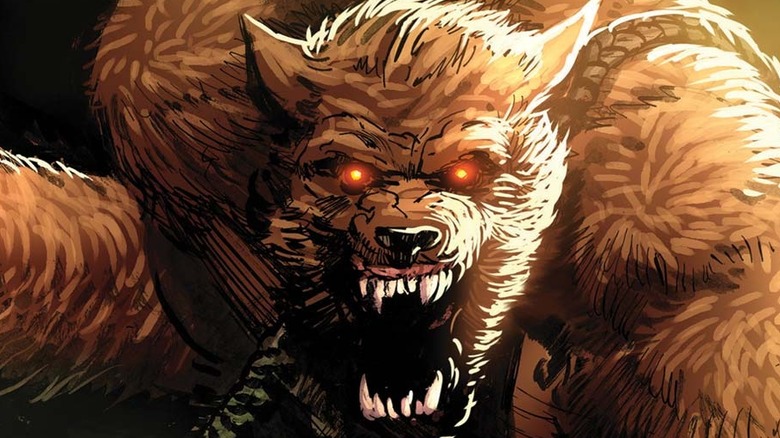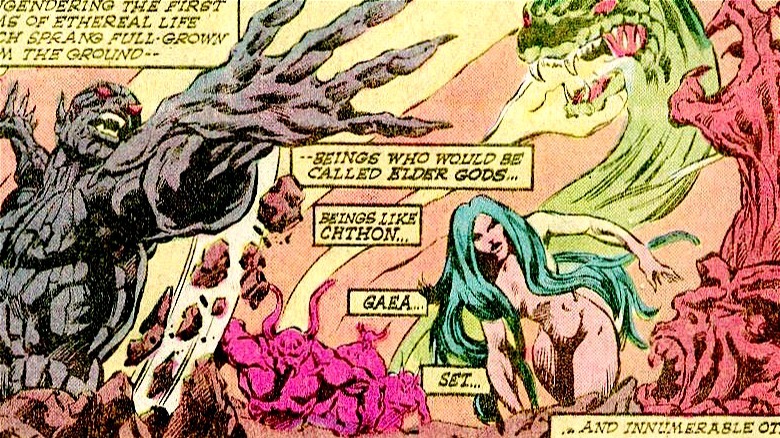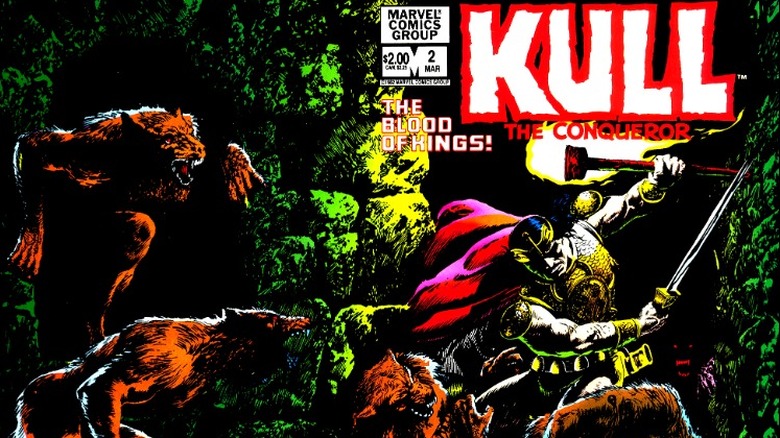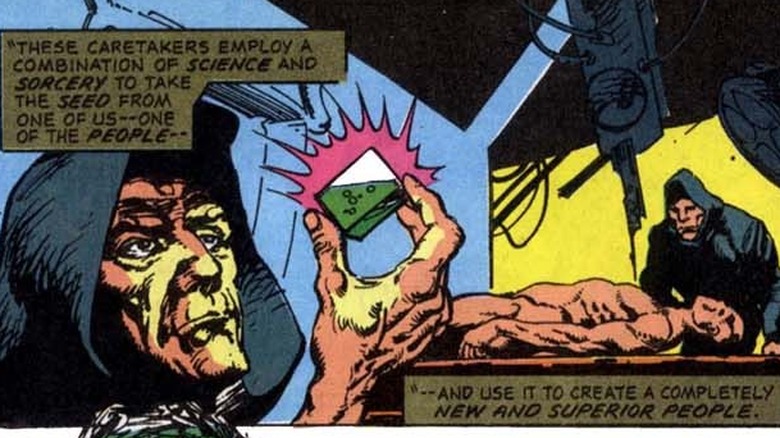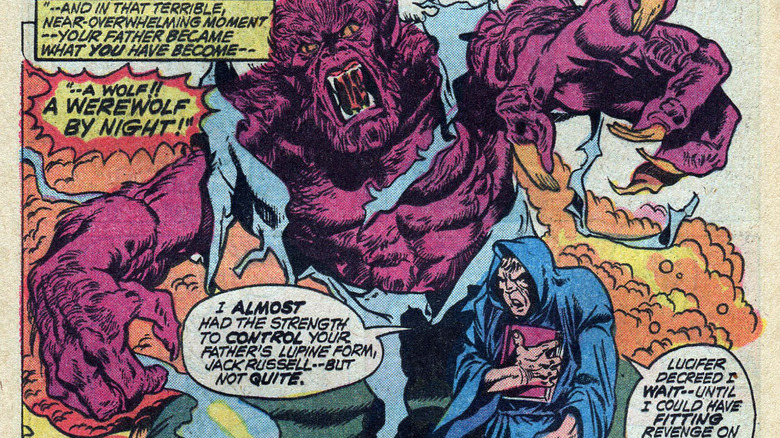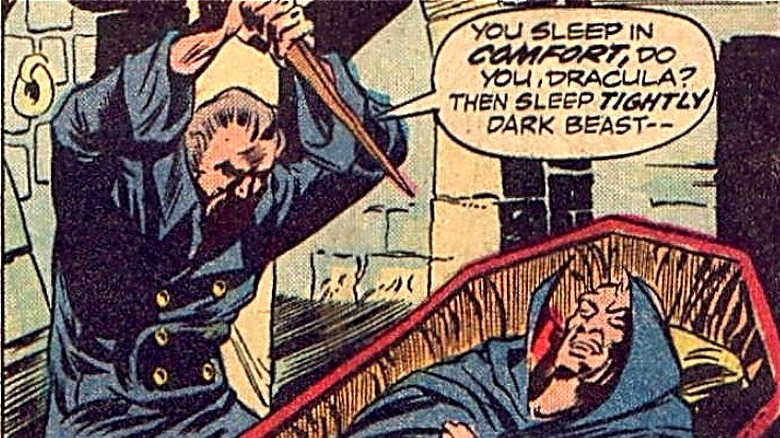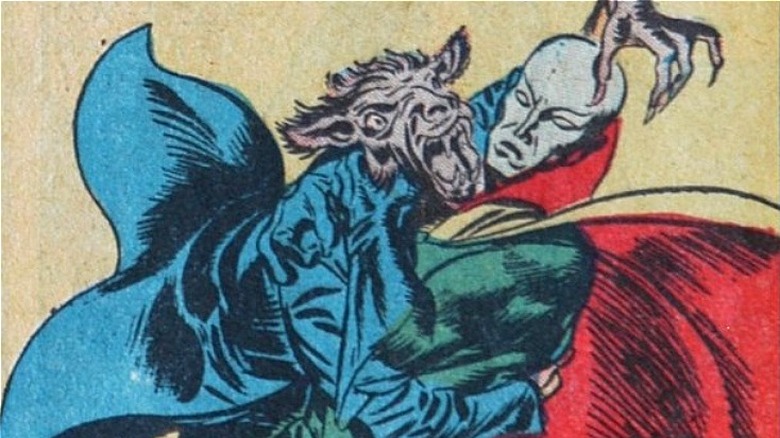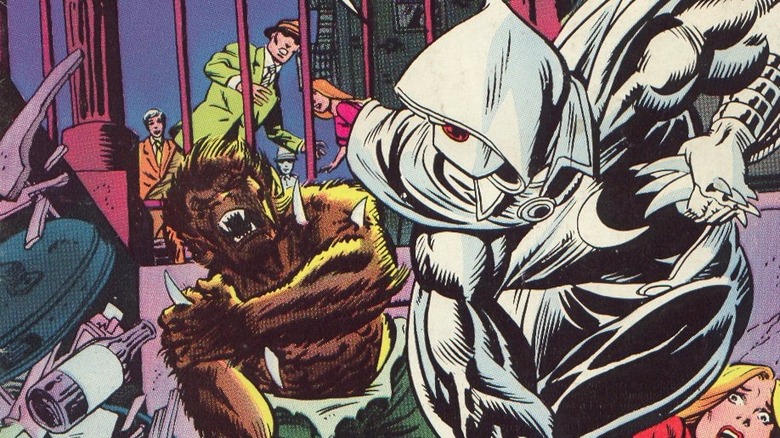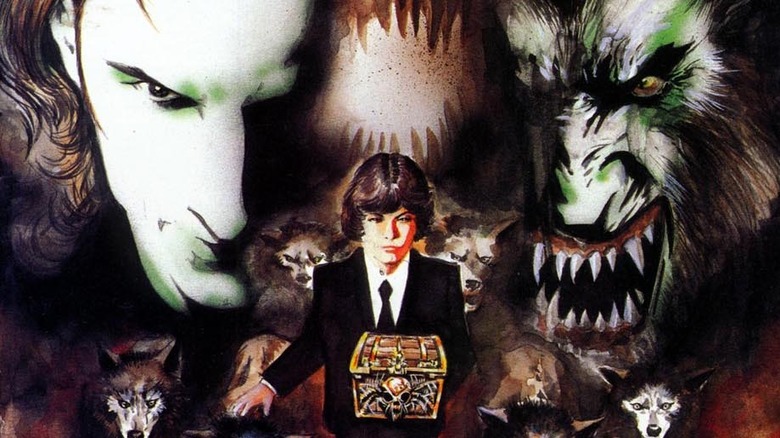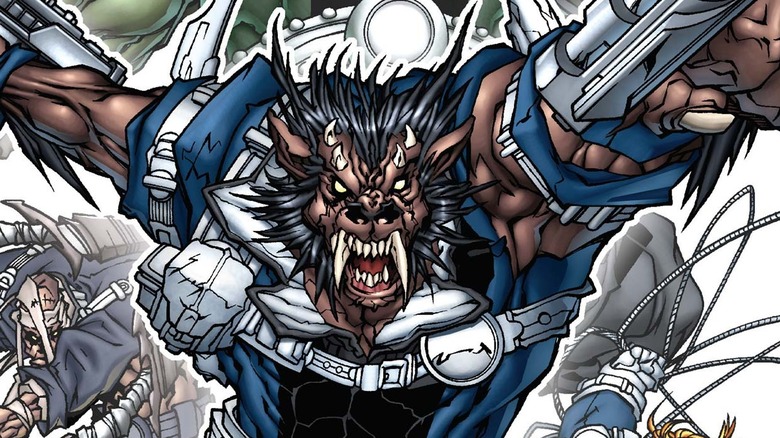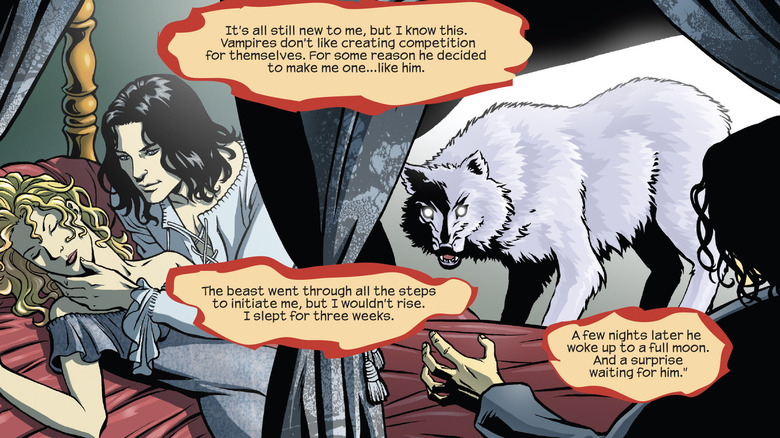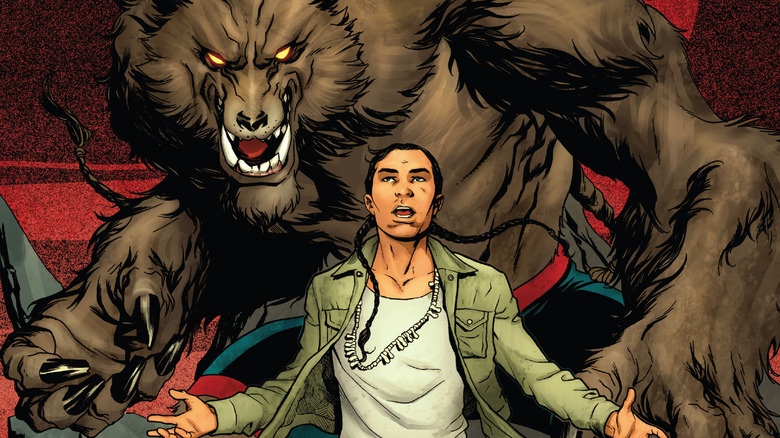The History Of Marvel Werewolves Explained
The next full moon, take a moment to stop, close your eyes and listen. That mournful howl you hear far off in the distance — is it a dog? Or a werewolf? Lycanthropes have fascinated humans for centuries, so it's no surprise that they've been a mainstay in Marvel comics since the company's inception. Back in the '40s, Marvel (or rather, their predecessor, Timely Comics) was already pitting its fledgling superheroes up against the slathering, snarling creatures of the night.
As superheroes died off, Marvel moved to tell more werewolf stories in horror books, stretching those tales from the '50s to the '70s. But it was only in that last decade that they hit upon a werewolf with staying power, one who could mix it up with the horror and spandex crowds all at the same time: Werewolf by Night. With his birth in 1972, Marvel began developing a rich, expansive werewolf mythology that ties all the way back to Earth's very beginnings.
With speculation that Marvel's most famous lycanthrope, Werewolf by Night, may be making his MCU debut soon, it seems like the perfect time to delve into Marvel's werewolf history. After all, knowledge is power. Learn the rules, study their origins — and you may just survive your next encounter with one of Marvel's growling, howling werewolves.
The darkest of origins
Werewolves in the Marvel universe are, for the most part, mystical creatures whose transformation robs humans of reason and awakens a terrible bloodlust. While they aren't inherently evil, the darkness that gave birth to them is. That dark power stems from Earth's earliest days, when molten lava cooled, the atmosphere crackled with energy, and the Demiurge came into being. Looking upon this fledgling planet, the Demiurge decided it needed life, so it created the Elder Gods, beings of great power to rule over it.
The dark history of these beings was first told in the "Thor" annual #10, and within a few panels, we learned that the Demiurge was gravely flawed in its creation. Nearly all of the Elder Gods grew dark and twisted, descending from gods to demons. And Chthon was the moat vile and evil of them all. Fond of studying things that should never be, he mastered the darkest of "death magic" and fueled his power through pain and suffering. He was also fond of experimenting, but back in those early days, he didn't have many creatures to experiment on. So he went to work on his fellow Elder Gods. His twisted tinkering turned one of them, Vârcolac, into the Wolf Demon.
In time, the only Elder God not to succumb to the darkness, Gaea, went to war with her siblings. Almost all of them were destroyed, but Chthon retreated to his own dimension, and Vârcolac, it turned out, his own hell.
The proto-werewolves
Though he fled, Chthon never quite lost his grip on the world, returning time and again to bring his dark designs and experiment on those who now lived on Earth. In these hazy days before man gained a foothold, Chthon created a number of creatures dubbed "Elder Races." He influenced them with indestructible scrolls filled with his cursed knowledge, altering the course of history whenever he could.
One place where Chthon's creations ran smack into history was with the Wolf-Men of Valusia. Audiences first met the Wolf-Men back in "Kull the Conqueror" #2, where they were the last remnants of one of the most power Elder Races, and had once held sway over the world and enslaved humanity. By Kull's time on Earth in 18,500 BC, the Wolf-Men were few, but vicious, a thorn in his side trying to overthrow his kingdom and all humanity.
Like werewolves, they could shape-shift into humans, were supernaturally strong and fast, and vulnerable to silver. According to the "Official Handbook of the Marvel Universe" #13, they were distant relatives to modern werewolves and, while Chthon claimed them as his twisted creations, they were spawned through another of his monstrosities the wolf demon Vârcolac. Like many of Chthon's Elder Races, he made them by merging demons, animals, and humans together into one blasphemous whole. But as powerful as they once were, when the Great Cataclysm sank Atlantis and Lemuria in 18,000 BC, the Wolf-Men were seemingly wiped out for good.
Modern werewolves are born
With the Elder Races wiped out, and the Wolf-Men gone for good, there was now apparently room in the food chain for replacements. That, according to "Dr. Strange, Sorcerer Supreme" #26, was where the Caretakers of Arcturus decided to step in about 10,000 years ago. They were somewhat obsessed with their "seed" technology and used it all around the world, creating things like the Cat People and early mutant super-humans.
But the Caretakers made their most lasting contribution to Earth when they kidnapped a man and implanted him with the "seed" of a wolf named Windracer. They couldn't accomplish this with their science alone, so they tapped into the power of Vârcolac (the wolf demon) to aid them. When they were finished, Earth had its first true werewolf: Greysire.
It didn't take long for Greysire to spread his lycanthropy, as all he needed was to scratch or bite someone to pass it on. These early werewolves, though, were noble creatures, able to switch back and forth at will. It was only after many centuries that werewolves lost the knowledge of the transformation and humans lost touch with their primal selves. On top of that, as his magic had been used to create the hybrids, Vârcolac began exerting his control over their wolf forms more and more. They became savage and monstrous, falling from the noble creatures of Greysire's beginnings to the monsters that all of humanity feared.
Chthon's Darkhold legacy
Millennia passed and Chthon's scrolls made their way through humanity, corrupting all those who found them. Eventually, according to "The Official Guide to the Marvel Universe" #2, Morgan le Fay bound them together into one tome called the Darkhold during the age of Camelot. She used the foul book to try to summon Chthon, but he was far too powerful to control. She realized her mistake too late, and was only able to send the Elder God back with Merlin's help. Afterwards, the Darkhold was dismantled and scattered throughout the world.
That mostly kept the scrolls out of human hands until 1149, when a monk named Aelfric gathered them once again as he gave his soul over to a being he thought was Lucifer — but was actually Chthon. When his fellow monks discovered his blasphemies, they burned him at the stake, but the scrolls survived and were passed down through the ages and reassembled again. The mad monk Aelfric also survived, in a way. 800 years later, in the pages of "Werewolf by Night" #3, he possessed the body of Father Ramon Joquez while he was attempting to translate the Darkhold for the Werewolf, Jack Russell.
It's never entirely clear how much information the Darkhold has on werewolves, but Aelfric certainly seems to have learned plenty, claiming he was almost able to control Jack's grandfather (father? Great-grandfather? Marvel's sliding time scale keeps changing the relationship) in wolf form while he was a spirit.
The birth of a curse
Most of what we know about werewolves in the Marvel universe comes from years of mythology, fleshed out in tales of the Werewolf by Night. The Werewolf never would have existed, however, if his ancestor hadn't damned the family in the 18th century. It began back in 1795 when Russell's Hungarian ancestor, Baron Grigory Russoff, earned the ire of Dracula for refusing to bow down to the vampire. Dracula retaliated by killing the baron's wife, Louisa, starting a tit for tat that would doom generations.
Enraged, Russoff made good on his promise to take Dracula out. He walked right into the castle that, apparently, Dracula felt needed no protection or lock, and staked the foul vampire right in the heart. Dracula died (for a time), and the broken Russoff went through the castle, smashing everything he encountered — until he found a woman named Lydia locked in a room. He freed her, but as they walked away under the light of the full moon, she underwent a monstrous transformation. The wolf creature that took her place bit the Baron in the neck, oddly enough sparing his life, but cursing him with lycanthropy.
In the Marvel universe, thanks maybe to the Chthon's dark magic at the core of werewolves (or maybe because it's a convenient plot device), lycanthropy is hereditary. Naturally, the Baron's children had been born before he was turned, so they were spared the curse ... or, so he thought.
Werewolves meet the first superheroes
Werewolves were always big in Europe, but by the 18th century, they'd begun emigrating to the U.S. as well. These early werewolves seemed to maintain a lower profile, but that all went out the window by the 20th century when there was a veritable werewolf explosion. Along with that explosion came the first few clashes with the superhero community.
In 1940, the Vision (the first one, not the Avenger) clashed with a werewolf couple in 1940's "Marvel Mystery Comics" #14. Explorer Gordon Sanders became a werewolf after meeting his wife, Llhupa, in the lost Tibetan city of Howling Demons. Apparently deciding that was a fine place to meet a life partner he married her, only to discover Llhupa herself was a werewolf. She, of course, shared the curse with him, and he went on a rampage trying to cure himself. Llhupa slayed him for the attempt, only to be killed in turn by the Vision.
The werewolf that battled the Human Torch and Toro in 1946's "The Human Torch" #24 didn't fare much better. The heroes were summoned to Ridgefield, Connecticut to investigate a dangerous wolf. What they found was a middle-aged man named Jones, who didn't seem to realize he was a werewolf. Neither did the Human Torch, who snapped his neck — nor Jones' adoptive son, who shot him. No one knew what he was until he reverted back into human form as he died — and frankly, nobody seemed much fazed that he was dead.
The Werewolf by Night
Werewolves really got interesting at Marvel when they stepped out of the pages of horror comics and into a world of their own. It began with 1972's "Marvel Spotlight" #2, when Jack Russell (no dog jokes, please) turned into a werewolf on his 18th birthday. He soon got his own series — and in those early years, Jack lived in a dark world, fighting demons, necromancers, cultists, and even, like his ancestor, Dracula. Every now and then he mixed it up with some of the darker corners of Marvel's universe, teaming up with the likes of Ghost Rider, Man-Thing, and Morbius the Living Vampire to briefly form the "Legion of Monsters."
About the only hero he ever interacted with back in those days was Moon Knight, who debuted in the pages of "Werewolf by Night" #32. Moon Knight was a mercenary hired by the sinister Committee to capture Jack, and the moon motif and silver weapons made him the perfect foible for the Werewolf. But, upon learning that the Committee planned on turning the Werewolf into an assassin, Moon Knight turned on his employers and joined Jack to fight against them.
Afterwards, Jack stayed away from the costumed types for a bit, but after a literal run-in with Iron-Man in the last two issues of his series, he exploded onto the superhero scene. In time, he came to gain control over his werewolf self, and harnessing his powers he teamed up with the everyone from Spider-Man and Spider-Woman to Captain America and Doctor Strange.
Confronting the source
The Werewolf's life is constant battle for control over his wolf form, and after years of teaming up with superheroes, he found that control had begun to fade. Eventually, in 1998's six-issue "Werewolf by Night" run, he learned this was because of the cult of the Third Moon and more specifically, the monster they worshipped: Chthon's twisted wolf demon sibling, Varcolac.
But the wolf demon's power didn't just create and transform werewolves; the hellish being also exerted control over the unfortunate souls' wolf forms. It was a big reason why they had gone feral millennia ago, and why Jack could never seem to hold onto his own control for very long. Vârcolac was a hungry, violent, ancient creature, and when Jack descended into its hell to do battle for his very being, he learned that the demon tormented the souls of dead werewolves — including the souls of his own family.
It was a horrifying experience, but in the end, Jack accepted his animal side, defeated the wolf demon and returned to the world of the living as a new man, er, werewolf. The new Jack didn't spend as much time with the spandex crowd, outside of some run-ins with Moon Knight and Deadpool. Instead, he teamed back up with Man-Thing to form a new Legion of Monsters, then joined Morbius in an incarnation of Midnight Sons to combat the multiversal zombie threat in the fourth volume of "Marvel Zombies."
The werewolf pack grows
Jack, of course, wasn't the only member of his family to fall victim to the curse, nor was he the only werewolf with heroic tendencies. His little sister, Lissa, also transformed into a werewolf on her 18th birthday in "Werewolf by Night" #28. She, however, had the benefit of knowing what was coming, and help from Jack's onetime sorcerous enemy Taboo and the sorcerer's assistant Topaz helped manage the transformation.
As she underwent her first change, though, she was caught in a mystical battle between Taboo and the evil Dr. Glitternight (go easy on him — it was the '70s and sequins and glitter were in). Glitternight's dark energy struck Lissa, transforming her into a weredemon instead of a wolf, leading to a battle between her and her brother. It was only when Taboo sacrificed his life-essence that she was saved — and cured from the curse in the process.
Then there's Vince Marcus, otherwise known as Warwolf, the leader of Nick Fury's Howling Commandos (who debuted in the 2005 mini-series of the same name). His lycanthropy is a bit unusual, though, as his transformation is affected by Mars instead of the moon. He can transform at will any night, while maintaining his human intelligence. Although audiences never got an explanation for him, it is suspected his lycanthropy may be genetic rather than mystical. By the short-lived "Howling Commandos of S.H.I.E.L.D." series, Marcus had been replaced by Martin Reyna, who used a "warwolf gene pack" to transform into a werewolf at will.
A hybrid for the new millennium
Jack may have eased up on the superheroics a bit in recent years, but the family business is still intact with his niece, Nina. Lissa's daughter debuted in 2005's "Amazing Fantasy" #10 as Vampire by Night. She did, it turns out, inherit lycanthropy from her mother, even though Lissa had been cured. Nina hadn't seen her mother since she was 12-year-old, and didn't seem to have much of a relationship with her uncle Jack, so she was caught completely by surprise when she changed into a werewolf on her 18th birthday.
Horrified, she traveled the world looking for a cure, ending up in the Carpathians where a vampire decided he wanted to turn her into one of his own. It didn't work quite right, though, and Nina survived ... more or less. She became a living human by day, a vampire by night, and a werewolf under the full moon.
Nina is unique in that she has all the powers of a vampire and werewolf, but none of their weaknesses. Sunlight doesn't bother her, nor does a stake to the heart. While she goes feral under the full moon, by 2016, she seemed to have gained enough control to be able to transform into a wolf at will. Eventually, after finally meeting her uncle Jack, she joined the Howling Commandos in 2005. As of 2016's "Howling Commandos of S.H.I.E.L.D.," she was still a part of team.
A new breed of werewolf
When last we saw Jack Russell in 2017's "Deadpool" #28, his head had been blown off by the Merc with a Mouth for sleeping with Deadpool's succubus wife (yup), Shiklah. Jack survived, but it takes time for a head to grow back. In short, it was time for a new Werewolf by Night. That new Werewolf is Jake Gomez, a 17-year-old Hopi teen living on a reservation — and in his 2020 "Werewolf by Night" miniseries, the werewolf rules got thrown out the window.
Jake first changed at 13, rather than 18, and he can change every night, mostly depending on his emotional state. His curse, too, is passed down through the family, but while his father couldn't control his wolf form, Jake has managed to reign his beast in with help from his grandmother and a playlist made by his sister. Apparently it helps him regulate his emotions enough to not go on a murderous rampage. According to one story, Jake's family curse began when one of his ancestors drank a potion brewed by a wise man to turn him into a wolf. It was meant to be temporary, but when the wolf killed, he and his descendants were cursed with lycanthropy.
Jake soon graduated from fighting local thugs on the reservation to fighting an evil pharmaceutical company that was kidnapping his people. While he seems poised to be the future of the Marvel werewolves, only time will tell how he ties into Jack and more conventional werewolves.
